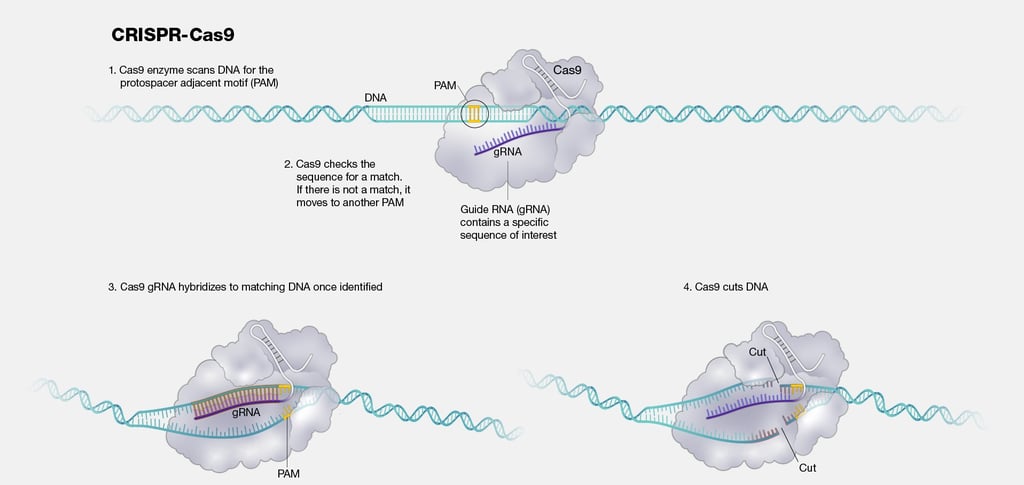🧬 CRISPR Gene Editing: The Future of Genetic Precision
: What is CRISPR? Gene Editing Revolution: Explained .Learn how CRISPR is transforming science—from curing genetic disorders to revolutionizing agriculture. Full breakdown with applications, ethics, and expert insights.
GENETICS


🔍 Introduction: A Scientific Revolution Begins
CRISPR, short for Clustered Regularly Interspaced Short Palindromic Repeats, is not just another biotechnology buzzword—it represents a true leap forward in our ability to understand and manipulate life at the genetic level. Discovered in bacteria as a natural immune defense, it has been engineered into a powerful gene-editing tool by scientists.
Since 2012, CRISPR-Cas9 has changed the landscape of biology, offering hope for previously incurable diseases and opening new frontiers in agriculture, diagnostics, and even environmental sustainability.
🧠 What is CRISPR and How Does It Work?
At the core of CRISPR technology lies the Cas9 enzyme—a protein that acts like precision scissors—and a guide RNA (gRNA) that directs Cas9 to a specific location on the DNA strand.
The CRISPR-Cas9 Process:
Guide RNA is engineered to match the target gene.
Cas9 is introduced into the cell, where it cuts the DNA at the precise location.
The cell’s natural repair mechanisms either:
Disable the gene (gene knockout), or
Replace it with a new sequence (gene correction or insertion).
This mechanism allows researchers to “edit” the genome with precision never before possible.
🌱 Real-World Applications of CRISPR
🏥 1. Medicine and Therapeutics
Curing Inherited Disorders: CRISPR is being trialed to treat sickle cell disease, thalassemia, and cystic fibrosis.
Cancer Immunotherapy: T-cells are being engineered to recognize and kill cancer cells.
Infectious Disease: Experimental therapies aim to eradicate HIV by editing viral DNA out of human cells.
✅ Notable Breakthrough: In 2023, the UK approved the world’s first CRISPR-based treatment for sickle cell anemia and β-thalassemia, paving the way for wider adoption.
🌾 2. Agriculture
Crop Engineering: CRISPR helps develop drought-resistant, pest-proof, and higher-yield crops.
Allergen-Free Foods: Editing genes in foods like peanuts or wheat to reduce allergic reactions.
Livestock Enhancement: Improving disease resistance and productivity in animals.
🧪 3. Biomedical Research
Disease Modeling: Scientists create genetically edited animals to mimic human diseases.
Functional Genomics: Studying the role of individual genes by knocking them out or modifying them.
⚖️ Ethics and Limitations
Despite its massive promise, CRISPR is not without challenges:
ConcernDescriptionGermline EditingEditing embryos can pass changes to future generations.Off-Target EffectsCas9 might cut unintended parts of DNA, causing mutations.Access & EquityWill life-saving therapies be available to all or just the wealthy?Ethical Gray ZonesDesigner babies, gene doping in sports, and biohacking raise deep ethical issues.
Leading organizations such as the World Health Organization (WHO) and National Institutes of Health (NIH) are actively working on ethical guidelines and global standards.
🔮 The Future of CRISPR
CRISPR is evolving beyond simple gene editing:
Prime Editing: A next-gen technique allowing more precise DNA corrections without cutting both DNA strands.
Base Editing: Direct chemical conversion of individual DNA letters (A, T, C, G).
CRISPR Diagnostics: Tools like SHERLOCK can detect diseases like COVID-19 quickly and cheaply.
Epigenetic Editing: Altering gene expression without changing the DNA sequence itself.
💡 Forecast: According to Grand View Research, the global CRISPR market is expected to surpass $15 billion by 2030.
📚 Authoritative Resources & Research
To ensure the scientific credibility of this article, here are key sources and research links:
NIH: Genome Editing Overview
🧾 Conclusion
CRISPR is more than just a scientific marvel—it’s a transformative technology redefining what’s possible in medicine, agriculture, and beyond. Its simplicity, affordability, and power make it one of the most exciting tools in biology.
As we step into a future where genes can be edited with a click, the responsibility lies with researchers, policymakers, and the public to guide this tool ethically. CRISPR may allow us to rewrite DNA, but how we write the next chapter of humanity is still in our hands.
Here are links to key research reports and resources on CRISPR, based on the latest available information. These sources provide in-depth insights into CRISPR advancements, applications, and market trends:
MarketsandMarkets - CRISPR Technology Market Report
Details: Comprehensive analysis of the CRISPR market, valued at $3.21 billion in 2025, with projections to $5.47 billion by 2030. Covers applications, end-users, and regulatory challenges.
Link: https://www.marketsandmarkets.com/Market-Reports/crispr-technology-market-134401204.html
Nature Reviews Genetics - CRISPR-Cas9 Advancements
Details: Reviews high-fidelity Cas9 variants and compact Cas12f systems, focusing on specificity and delivery innovations.
Link: https://www.nature.com/nrg/ (Search for "CRISPR-Cas9 advancements" for specific articles)
ScienceDirect - Bibliometric Study on CRISPR and Extracellular Vesicles
Details: Analyzes 219 publications (2015–2022) on CRISPR delivery via extracellular vesicles, highlighting trends and research gaps.
Link: https://www.sciencedirect.com/science/article/pii/S0167779923002458
xAI Grok - General CRISPR Information
Details: For additional context or updates on CRISPR, explore xAI’s platform for curated insights.
Link: https://x.ai/grok
National Institutes of Health (NIH) - Clinical Trials on CRISPR
Details: Access ongoing CRISPR-based clinical trials, including those for sickle cell anemia, cancer, and HIV.
Link: https://clinicaltrials.gov/ (Search for "CRISPR")
